Day 3 of a three day long weekend of Autumn Migration Tours today, our last day. It was very windy, gusting 40mph+, as ‘Storm Brian’ continued to make its way slowly across the UK. Fortunately it was mostly dry, apart from a brief burst of rain late morning. Nothing to stop us getting out and enjoying a good day.
As we made our way west along the coast road first thing this morning, we stopped briefly along the road at Burnham Overy to have a look at the geese. There were lots of Greylag Geese feeding in the stubble, and several small groups of Pink-footed Geese too. In with them were a good number of Egyptian Geese. More Pink-footed Geese were flying in to join them, but we couldn’t find any sign of anything else yet.
 Egyptian & Greylag Geese – feeding in the stubble at Burnham Overy
Egyptian & Greylag Geese – feeding in the stubble at Burnham Overy
Our first destination for the day was the RSPB reserve at Titchwell. As we pulled up in the car park, a tit flock was feeding in the trees just above all the cars. We could see several Long-tailed Tits along with a number of Blue Tits and a Goldcrest. A Chiffchaff was calling nearby. Below the trees, on the curb, a Goldfinch was feeding on the seedheads of a burdock.
 Goldfinch – in the car park at Titchwell
Goldfinch – in the car park at Titchwell
It was still relatively quiet, not too many cars, so we had a look around the overflow car park first. As we carefully looked round the corner, there were lots of Chaffinches and Goldfinches feeding on the ground around the edges. Several more finches came down to drink at a puddle in the middle, including two Greenfinches. A Blackcap was feeding in the brambles at the back. As we walked round, we flushed several Blackbirds from the bushes and a couple of Bullfinches flew across in front of us, flashing their square white rump patches, before disappearing into the sallows.
The feeders by the visitor centre held the usual selection of birds – a mixture of Chaffinch, Greenfinch, Goldfinch and tits. We headed out along Fen Trail first this morning. We could hear Long-tailed Tits calling when we arrived at the Meadow Trail junction, so we stopped to listen. A Kingfisher called from the back of the dragonfly pool, but by the time we had got round to the viewing platform it had flown off.
As we walked back to Fen Trail, a flock of Siskins dropped in to the top of the alders. There are still lots of leaves on the trees and we couldn’t see them until they flew off again. The tit flock passed through the trees above our heads, but there didn’t appear to be anything else in with them. It was more sheltered on the tank road and there were more finches in the trees here. As we stopped to look through them, we heard a Yellow-browed Warbler calling, but it was deep in the sallows. As we had already seen several over the last two days, we decided not to stop here to try to see it.
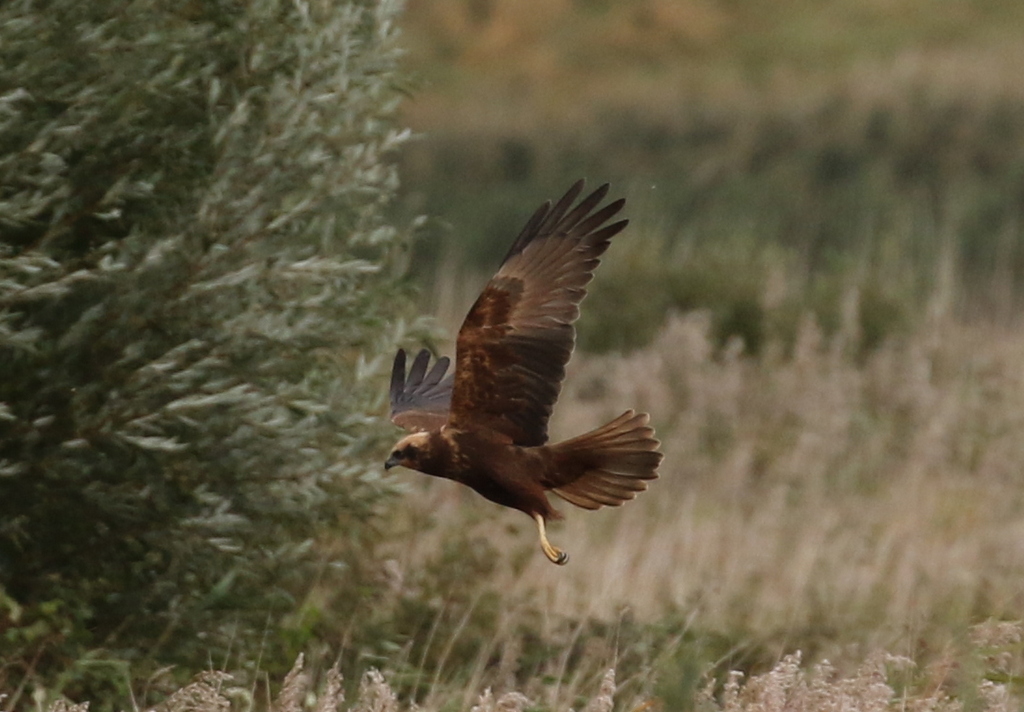 Marsh Harrier – one of two enjoying the wind over the reedbed
Marsh Harrier – one of two enjoying the wind over the reedbed
Round at Patsy’s Reedbed, two Marsh Harriers were enjoying the wind, flying round above the reeds and occasionally circling out over the water. There were a few ducks on here – mostly Mallard, Teal and Shoveler. A lone Tufted Duck was in with them and a Little Grebe was diving out in the middle. Three Common Snipe were feeding or bathing along the edge.
Continuing on towards the Autumn Trail, we flushed several more Blackbirds and a couple of Song Thrushes from the hedges. There was no sign of the Little Owl here though – it was very windy and it was probably very sensibly tucked up somewhere more sheltered. But as we turned the corner by Willow Wood, we looked across the reedbed and spotted a Bittern flying over. We watched it as it flew across and dropped down into the reeds beyond the end of the line of dead trees.
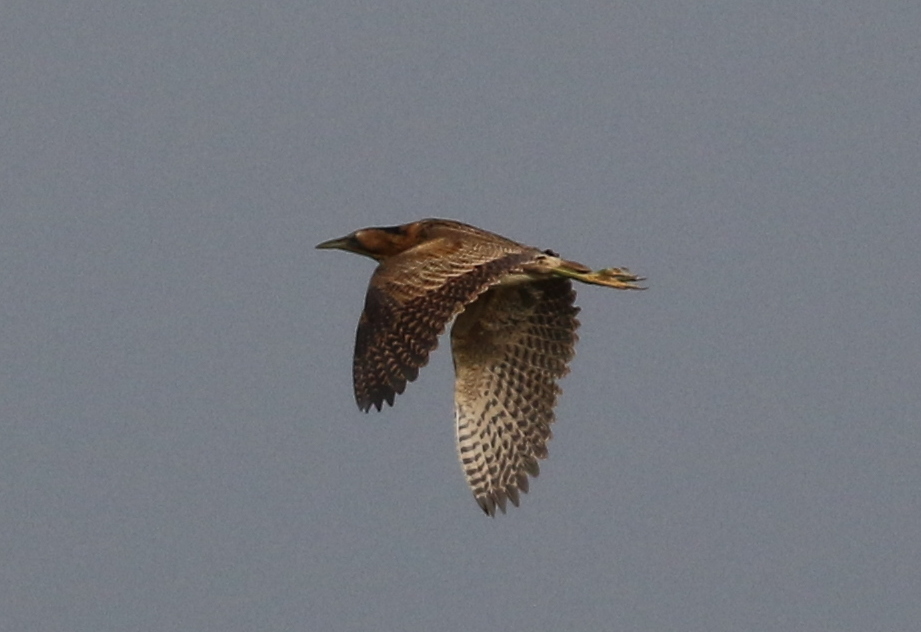 Bittern – flew over the reedbed as we walked round to Autumn Trail
Bittern – flew over the reedbed as we walked round to Autumn Trail
It was very exposed out on the end of Autumn Trail, and the wind was whistling in. We could see two Spotted Redshanks out with lots of ducks roosting over by the fence at the back of Avocet Island, but all the birds were very flighty in the wind. We turned to see some very dark clouds approaching from the west, so we didn’t linger here and beat a hasty retreat.
We made our way round via Meadow Trail to the main path. There had been a Water Pipit earlier on the Thornham grazing marsh ‘pool’, but we couldn’t see it. It was very gusty here and starting to spit with drizzle, so we didn’t look very thoroughly, figuring we could have another look later. We headed along to Island Hide, where we could get out of the wind. As we walked along the path past the reedbed, several flocks of waders flew past, presumably heading off inland to feed in the stubble fields. They were mostly Black-tailed Godwit and Ruff, but three Turnstones flew past with them too.
Our timing was good, because we hadn’t been in Island Hide long, before it started to rain. There were plenty of birds on here to look through, to keep us busy, though with the blustery SW wind the water was mostly over the far side and the mud in front of the hide was comparatively dry. There seemed to be quite a few Dunlin when we arrived, in several small flocks scattered around the islands, but numbers appeared to be thinning as birds flew off to feed elsewhere. We quickly located one of the Little Stints out on the mud and had a good look at it through the scope, but it was rather mobile.
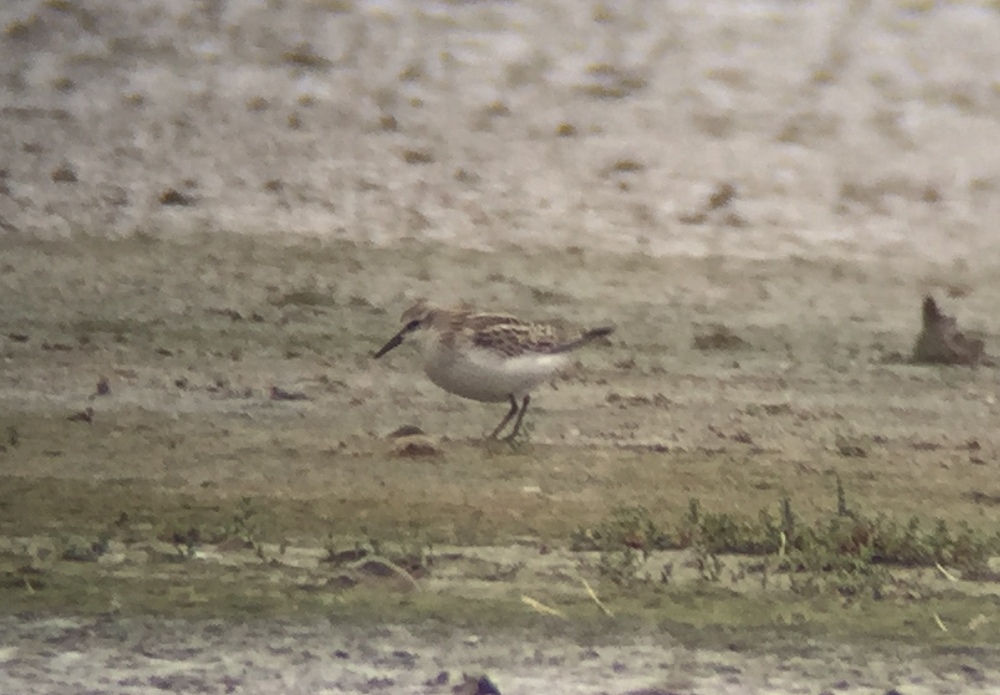 Little Stint – one of the juveniles on the Freshmarsh
Little Stint – one of the juveniles on the Freshmarsh
There were still a few Black-tailed Godwits and Ruff around one of the islands and a lone Avocet was feeding in the deeper water towards the back. Most of the Avocets have headed off south for the winter already, but there are typically a handful which attempt to stay here, depending on the weather. A single Turnstone and a Grey Plover dropped in briefly.
Thankfully it stopped raining fairly quickly and we took advantage of it to walk round to Parrinder Hide. There was a better view of all the ducks from here – Teal, Wigeon, Shoveler and Gadwall. We got a smart drake Gadwall in the scope and admired its intricately patterned plumage. The most underrated of ducks! The drake Teal in front of the hide were all in various stages of moult, some still mostly in duller eclipse plumage but one or two already back to smart breeding attire.
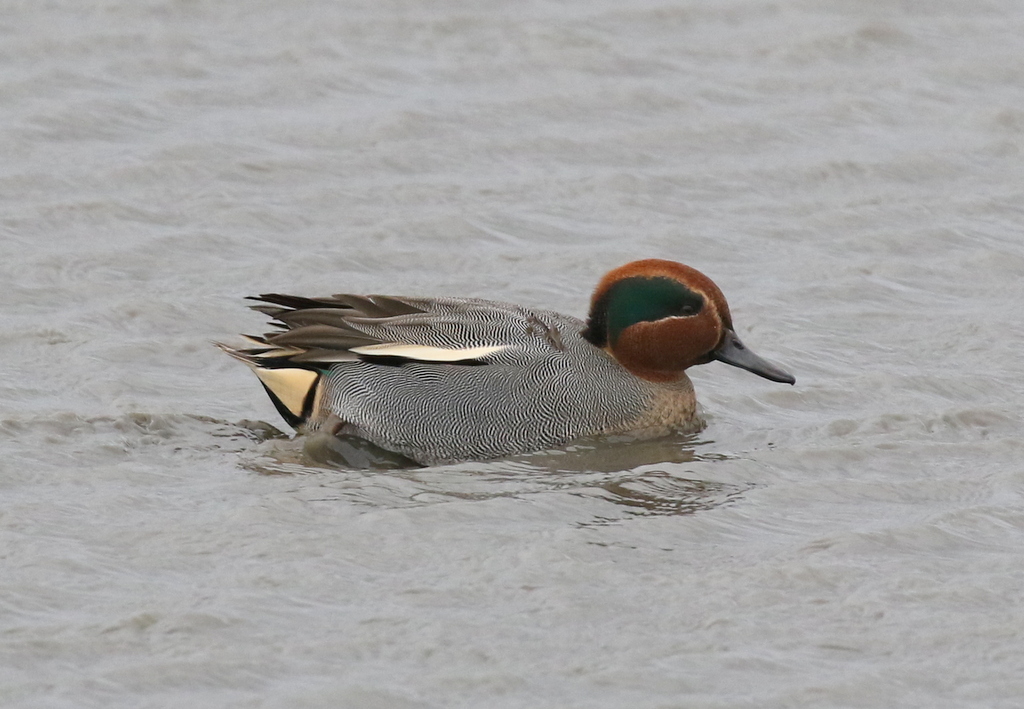 Teal – a smart drake, already moulted back out of eclipse plumage
Teal – a smart drake, already moulted back out of eclipse plumage
One of the volunteers had seen what might have been a Water Pipit in the vegetation on one of the islands in front of Parrinder Hide earlier, when looking across from Island Hide. We had a good look but there was no sign of it from here – just a couple of Pied Wagtails and Linnets.
The other side of Parrinder Hide, overlooking the Volunteer Marsh, seemed to be filled mostly with people huddled behind the glass windows eating their sandwiches. This was a shame, as there was a lovely close Bar-tailed Godwit feeding right below the front of the hide. We opened one of the windows, to disapproving grumbles from the picnickers, and had a good look at it. It was a juvenile, its upperparts very strongly patterned with thick blackish feather centres.
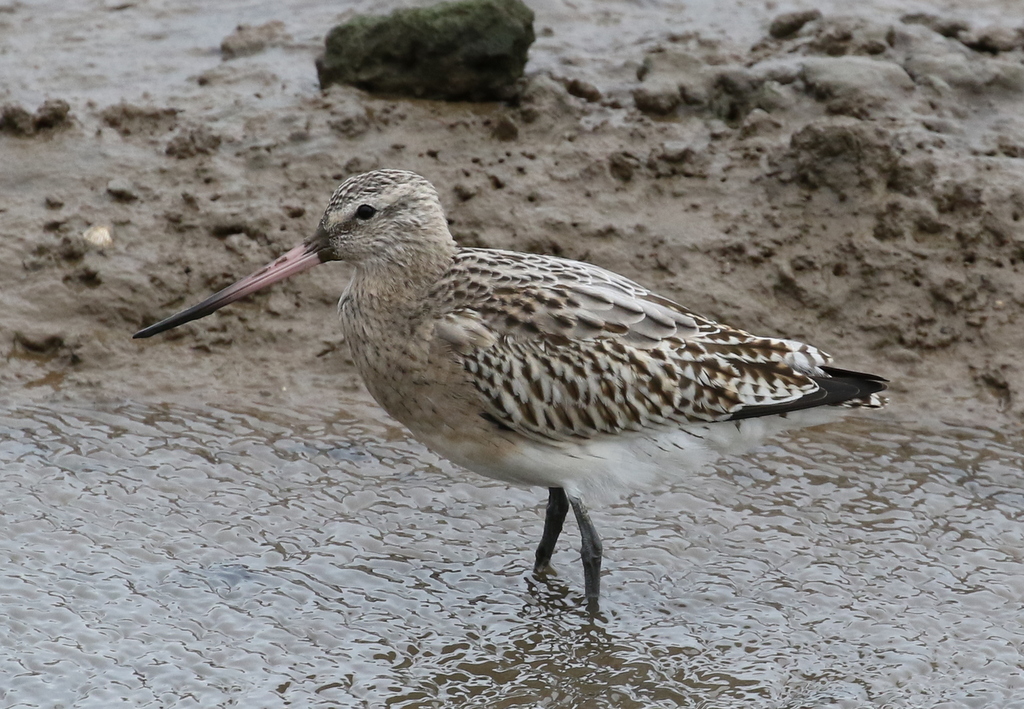 Bar-tailed Godwit – on the Volunteer Marsh right below the hide
Bar-tailed Godwit – on the Volunteer Marsh right below the hide
Even better, there was a Black-tailed Godwit right next to it, giving us a great opportunity to compare the two. The Bar-tailed Godwit was noticeably smaller and shorter legged, with a slight upturn to its bill. The Black-tailed Godwit was an adult in non-breeding plumage, and was noticeably duller, greyer with no obvious patterning to the feathers of it upperparts, very different in appearance from the Bar-tailed Godwit.
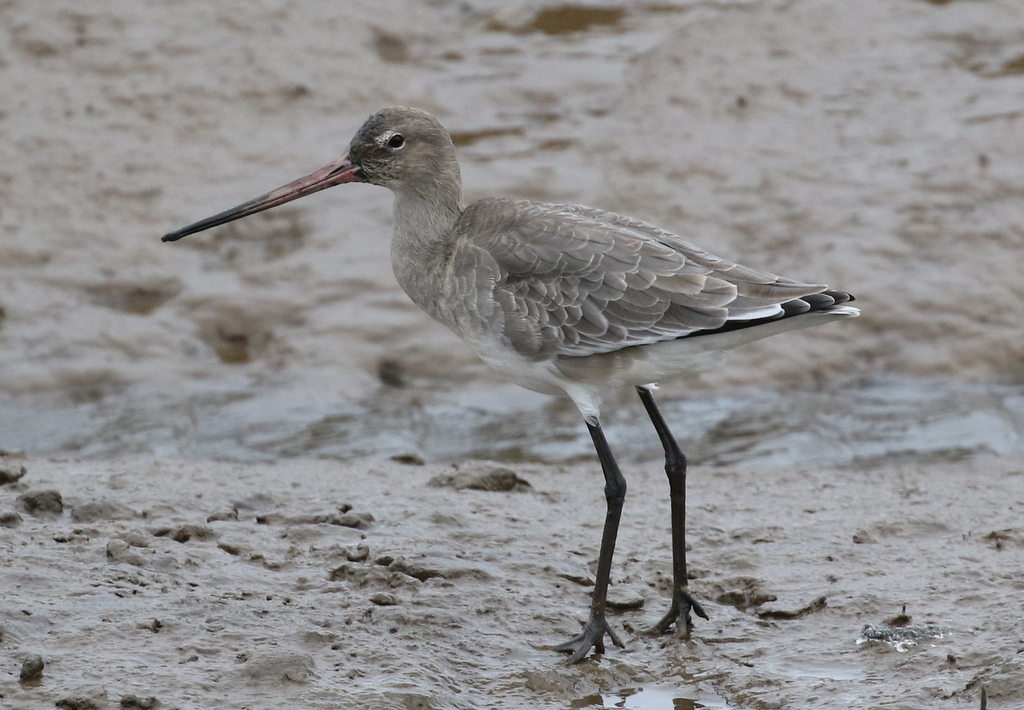 Black-tailed Godwit – a nice comparison, next to the Bar-tailed Godwit
Black-tailed Godwit – a nice comparison, next to the Bar-tailed Godwit
There was a fairly close Curlew here too, which had found a sheltered spot behind a tussock of grass to stand and preen. We had a look at that through the scope too, admiring its intricately patterned plumage. We could also see a few Grey Plover and Redshank out on the mud. A large flock of Linnets flew across in front of the hide.
It was already just about time for lunch, so we made our way back towards the Visitor Centre. On the way, we had a quick look for the Water Pipit on the Thornham grazing marsh pool, but it was still hard going looking into the wind and we couldn’t see it. We found a sheltered picnic table in the trees for lunch.
After lunch, we decided to head back out to the beach. It had stopped spitting with rain, even if it was still rather windy, so we had a proper look out at the grazing marsh pool this time. With a bit more effort, we found the Water Pipit, sheltering from the wind behind a clump of rushes. We could see its pale supercilium and wingbar, and rather pale white ground colour to the underparts with black streaks on the breast.
As we passed the Volunteer Marsh, there was a nice close Redshank feeding just below the path. As usual, there were a lot more waders on the muddy channel at the far end – several Ringed Plover and Dunlin, a Grey Plover, plus more Black-tailed Godwits, Redshank and Curlew.
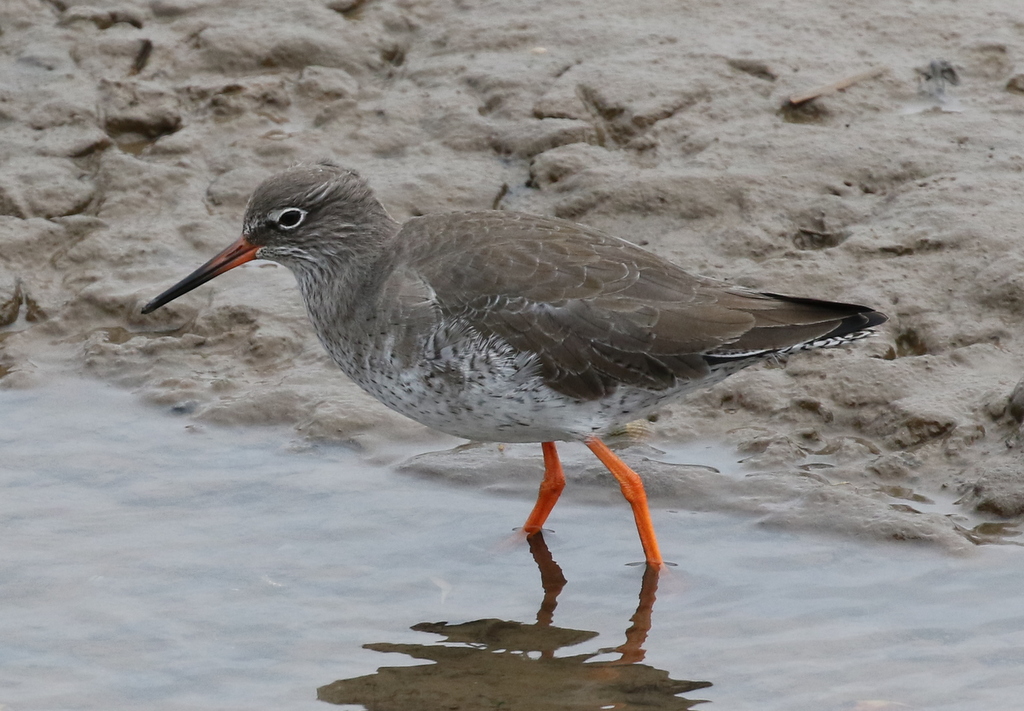 Redshank – feeding by the main path
Redshank – feeding by the main path
It was rather exposed and windy out at the Tidal Pools, where a Little Grebe was diving next to the path and several more Black-tailed Godwits were feeding around the islands. We made our way quickly on to the beach, where we could get some shelter from the wind on the other side of the dunes.
A quick scan of the sea revealed a single Common Scoter close inshore, just off the beach. Two more Common Scoter were a bit further out and harder to see in the swell, along with three Great Crested Grebes. A couple of Gannets were circling offshore and diving for fish.
There was a nice selection of waders on the beach – Oystercatchers and Bar-tailed Godwits. A couple of Sanderlings dropped in briefly on the sand. There were more waders on the mussel beds – a nice little group right on the near end where they were easier to see included a single Knot, with two Grey Plover, a Redshank and a Turnstone.
As we started to head back, a female Stonechat flew across the path in front of us. We stopped to watch here feeding, flicking out from the Suaeda bushes in the lee of the bank to look for insects on the edge of the dunes. Then it was heads down, as we walked back into the wind.
 Stonechat – feeding on the edge of the dunes on our way back
Stonechat – feeding on the edge of the dunes on our way back
Once we got back to the car, we drove round to Thornham Harbour. It was windswept here, with lots of disturbance from Sunday afternoon walkers. We had a quick look in the harbour channel, which held singles each of Bar-tailed Godwit, Black-tailed Godwit, Curlew, Redshank and Grey Plover. But there was a distinct lack of small birds here today, in the wind. As we turned to leave, a quick glance up the channel behind the old coal barn revealed a single Spotted Redshank hunched up on the rocks, facing into the wind.
We headed inland and up to Choseley next. The first field we looked in had two Marsh Harriers, just standing around out in the middle. A little further up, another field was scattered with small brown lumps. When we stopped to look more closely, we could see it was liberally sprinkled with Golden Plovers. A small group of Curlews was feeding closer to the road and further over was a big mob of Starlings probing in the green winter wheat too.
The cover strip alongside the road has been very productive in recent weeks, but it was windy up here today and there were no birds in the seedy vegetation. A flock of Black-headed and Common Gulls was feeding in the winter wheat beyond. As we drove on, we saw several coveys of Red-legged Partridges and lots of Brown Hares in the fields.
It was time to start making our way back, but on the way we decided to make a quick stop back at Burnham Overy to look at the geese. Unfortunately, there were a lot fewer geese in the first field we checked, where a man was now walking his dogs. In the next field along, we found a few Greylags, Pink-footed and Egyptian Geese, but nothing else of note with them. Several skeins of Pink-footed Geese flew over, heading to the fields inland to gather before going off to roost.
Unfortunately, it was time for us to go now too. It had been another exciting three days of Autumn birding, with a very good selection of birds seen.
















